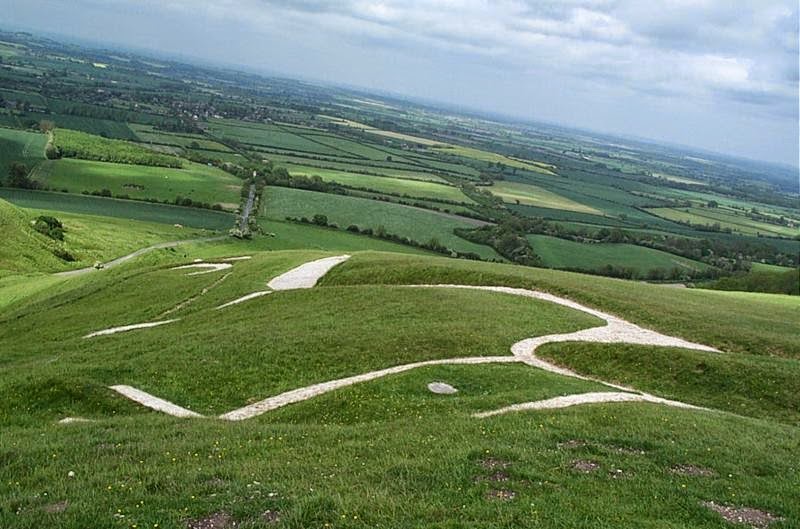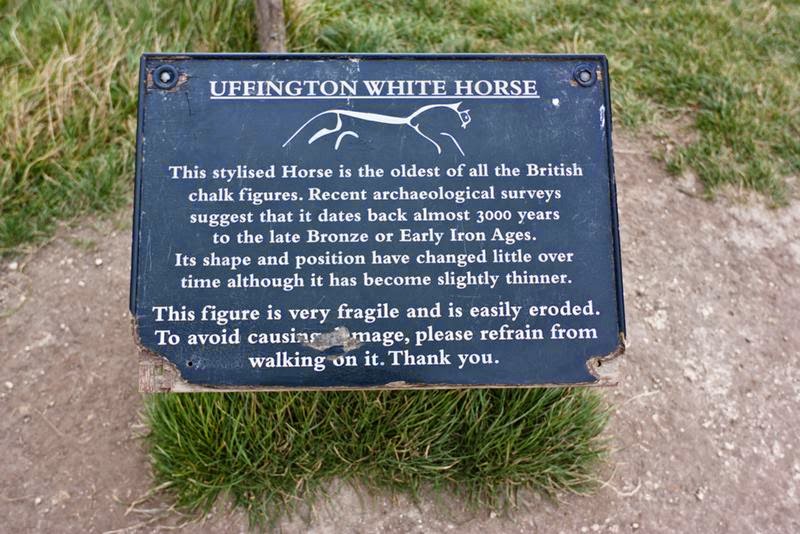The White Horse of Uffington, England
The Uffington White Horse is a highly stylized prehistoric hill figure, 110 meter long, formed from deep trenches filled with crushed white chalk. The figure is situated on the upper slopes of White Horse Hill in the English civil parish of Uffington (in the county of Oxfordshire, historically Berkshire), some 8 km south of the town of Faringdon and a similar distance west of the town of Wantage; or 2.5 km south of Uffington. The hill forms a part of the scarp of the Berkshire Downs and overlooks the Vale of White Horse to the north. Best views of the figure are obtained from the air, or from directly across the Vale, particularly around the villages of Great Coxwell, Longcot and Fernham. The site is owned and managed by the National Trust and is a Scheduled Ancient Monument.
 |
| Landscape format aerial view of the White Horse chalk hill carving near Uffington in Oxfordshire. Image credit Nick White |
The figure presumably dates to "the later prehistory", i.e. the Iron Age (800 BC–AD 100) or the late Bronze Age (1000–700 BC). This view was generally held by scholars even before the 1990s, based on the similarity of the horse's design to comparable figures in Celtic art, and it was confirmed following a 1990 excavation led by Simon Palmer and David Miles of the Oxford Archaeological Unit, following which deposits of fine silt removed from the horse's 'beak' were scientifically dated to the late Bronze Age.
 |
| Aerial photograph on display in the Tom Brown's School Museum in Uffington. Image credit Normann |
Iron Age coins that bear a representation comparable to the Uffington White Horse have been found, supporting the early dating of this artifact; it has also been suggested that the horse had been fashioned in the Anglo-Saxon period, more particularly during Alfred's reign, but there is no positive evidence to support this and the view is classified as "folklore" by Darvill (1996). Numerous other prominent prehistoric sites are located nearby, notably Wayland's Smithy, a long barrow less than 2 kilometres (1 mi) to the west. The Uffington is by far the oldest of the white horse figures in Britain, and is of an entirely different design from the others. It has long been debated whether the chalk figure was intended to represent a horse or some other animal. However, it has been called a horse since the 11th century at least. A cartulary of Abingdon Abbey, compiled between 1072 and 1084, refers to "mons albi equi" at Uffington ("the White Horse Hill"). [Source]

Image credit Dave Price

Image credit Giles Watson

Image credit Robert
 |
| Triskeli. The ear of the Horse. Image credit maxley |
 |
| The White Horse, the Manger and Dragon Hill, Uffington. An angle on the White Horse. Uffington Castle hill fort showing bottom left. Image credit Dave Price |
 |
| 3000 year old carving in the hillside at Uffington near Swindon. Made by digging pits and filling with chalk. Taken from a KAP rig suspended under a very old Brookite Cutter kite. Image credit Paul Chapman |
 |
| White Horse Hill, Uffington White Horse, Oxfordshire, June 2006. Image credit jackiesjottings |
 |
| Schoolchildren coming down from Dracon Hill (behind them - a dracon eye). Image credit Sharmanka Kinetic Theatre |

Image credit T.J. Morton
Source — Internet

No comments:
Post a Comment